Sights and Activities
Below are the places we saw and activities completed while visiting Argentina:
Buenos Aires
Obelisco: located on Avenida 9 de Julio, the city’s famous destination for sports fans to celebrate after a big win stands 67m (220ft) high and was built in 1936.
Avenida 9 de Julio: know to locals as “the widest street in the world!” It extends 16 lanes at its widest.
Plaza de Mayo: the city’s main plaza is the start of all demonstrations, including the weekly meetings of the Abuelas/Madres de Plaza de Mayo. The plaza is surrounded by the Casa Rosada, the Cabildo, and the city’s cathedral. The of the plaza hosts the Piramide de Mayo, a white obelisk built to mark the first anniversary of Buenos Aire’s independence from Spain.


Casa Rosada: the Pink House is the location of the offices of the president. There are two theories of why the house obtained its color: the first is could have come from President Sarmiento’s attempt at making peace during his 1868– 74 term by blending the red of the Federalists with the white of the Unitarists; and the second is that the color comes from painting the palace with bovine blood, which was a common practice in the late 19th century.
Metropolitan Cathedral: built on the site of an original colonial church, this cathedral dates back to 1827. The cathedral is a national historical site that contains the tomb of General José de San Martín, Argentina’s most revered hero.
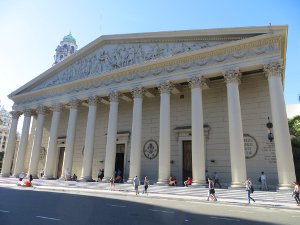
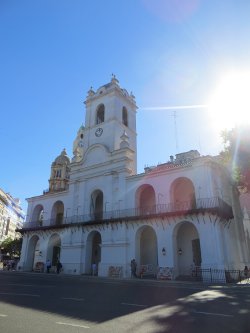
Cabildo: this mid-18th century town hall building used to have colonnades that spanned the Plaza de Mayo, but the building of surrounding avenues destroyed them.
“Quino’s” home: Badger Joaquín Salvador Lavado, known as Quino, is the famous cartoonist which his most famous work is the comic strip Mafalda. Statues of his cartoon characters can be found throughout San Telmo, the neighborhood where Quino had his home.
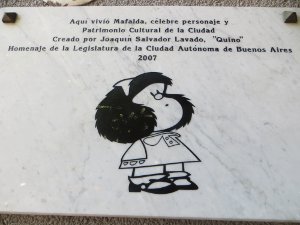

Puente de la Mujer: the “Women’s Bridge” is Puerto Madero’s signature monument. Designed by Spanish architect Santiago Calatrava, it was unveiled in 2001 and it is supposed to represent a couple dancing the tango.
Cementerio de la Recoleta: this cemetery is the city’s most popular attraction and we did not fall to any exception, we also made the visit. The cemetery is an amazing city of the dead, where countless ‘streets’ are lined with impressive statues and marble mausoleums. All of the city’s elite society is to put to rest here, including past presidents, military heroes, influential politicians, and the just plain rich and famous. We passed by the heavily visited grave of Evita.
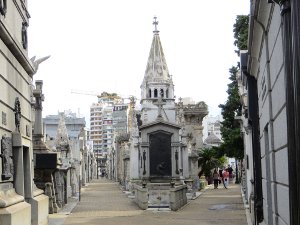
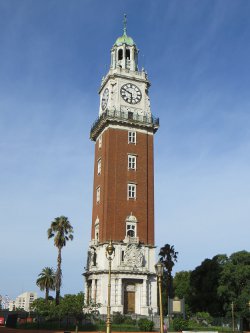
Plaza San Martin: designed by Carlos Thays, a French landscape architect, the plaza is home to a prominent statue of José de San Martín on equestrian.
Edificio Kavanagh: this 120m (394ft) art deco apartment building was the tallest skyscraper in Latin America at the time of its construction in 1935.
Torre de los Ingleses: located across from Plaza San Martín, this 76m (250ft) high miniature version of London’s Big Ben was a donation from the city’s British community in 1916.
- Plaza del Congreso: this plaza contains a monument, Monumento a los Dos Congresos, that honors the congresses of 1810 in Buenos Aires and 1816 in Tucumán, both of which led to Argentinian independence. The enormous granite steps on the monument symbolize the high Andes, and the fountain at its base represents the Atlantic Ocean. West of the plaza is the colossal green-domed Palacio del Congreso (Congress Building) completed in 1906.
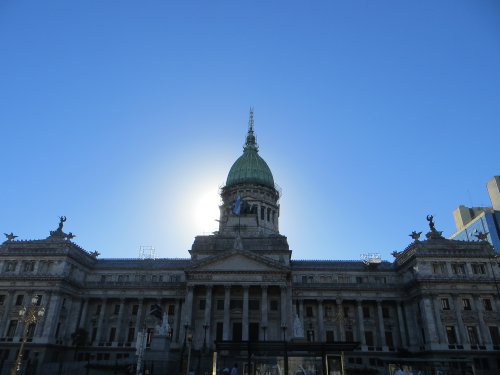
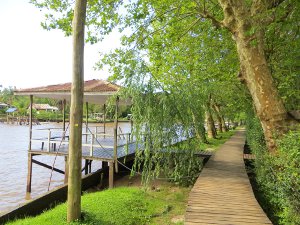
Tigre: this city, located 35km (22 miles) north of Buenos Aires, is surrounded by small canals in a delta region. We took a boat trip to Tres Bocas where we spent the day walking around the shaded peaceful landscape, which reminded us of South East Asia. The locals live along these peaceful canals with boats as their only transportation.
El Caminito: this street, located in La Boca neighborhood, contains colorful houses, tango dancers, and many tourists!
Museo Historico Nacional: the city’s national historical museum contains items related to Argentina’s revolution on May 25, 1810, including a recreation of military hero and liberator’s, José de San Martín, bedroom.
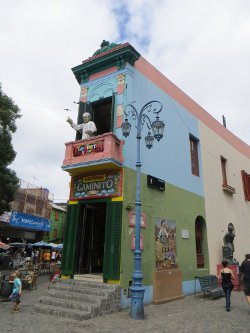
Plaza Dorrego: the city’s second oldest plaza dates back to the 18th century. It is the heart of the Sunday Feria de San Telmo, a street market with many souvenirs, vintage items, and street performers, including an entertaining tango show.
Mercado de San Telmo: this market was built in 1897 by Juan Antonio Buschiazzo, the same Italian-born Argentine architect who designed Cementerio de la Recoleta. The shops sell various items from fresh produce and meat to antiques, luggage, and other treasures.
Museo Espacio Memoria y Derechos Humanos, ex ESMA: this former Mechanics School Navy, better known by its acronym ESMA, was one of the largest and most active clandestine centers where political hostages were taken and tortured during the country’s last dictatorship. There has been more than 5000 disappeared. The building returned to its original function (housing senior officers of the Navy) after the return to democracy. In 2004, it was proposed as a museum to remember the repression, documenting state terrorism, then settling among others, the National Memory Archive. On August 5 of that year the government formed the “Space for Memory and the Promotion and Defense of Human Rights.” The space contains the history of the events and many survivor stories. There was also an exhibition on the Abuelas/Madres de Plaza de Mayo about the grandmothers and mothers of the captives and how they have tried to find them.

Palacio Barolo: located in the area of the Plaza del Congreso, the 22-story building definitely catches your eye. The building’s unique design was inspired by Dante’s Divine Comedy with its height (100m) is a reference to each canto (or song), the number of its floors (22) to verses per song, and its divided structure to hell, purgatory and heaven. Finished in 1923, Palacio Barolo was the city’s highest skyscraper until the construction of Edificio Kavanagh.
Palacio de las Aguas Corrientes: Swedish engineer Karl Nyströmer and Norwegian architect Olaf Boye helped create this gorgeous waterworks building.
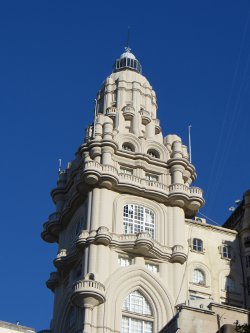
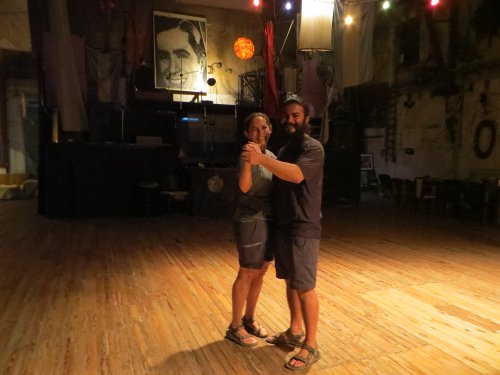
Plaza Lavalle: this plaza is surrounded by the austere neoclassical Escuela Presidente Roca built in 1902 and the French-style Palacio de Justicia (Palace of Justice).
Teatro Colon: also in Plaza Lavalle is the city’s seven-story, main performing arts venue. The building can seat 2500 spectators and provide standing room for another 500.
Milonga: we spent an evening taking tango lessons at the Catedral Milonga. Milongas are dance events that range from casual to traditional where locals go to dance tango. Classes are usually offered beforehand.
Colon
We reentered Argentina from Uruguay through this town, spending half-a-day walking around and trying the local cuisine. We strolled from the Plaza San Martin to the riverbank along leafy streets passing several artisan stores and finally trying the local river fish.

Rosario
Monumento Nacional a La Bandera: this monument honors the national flag and its designer, Manuel Belgrano, who rests in a crypt beneath the colossal stone obelisk that is built where the blue-and-white stripes were first raised. The colonnade houses an eternal flame commemorating those who died for the country.
Costanera: the city’s main waterfront stretches 15 km (9.3 miles), where an area of once derelict warehouses and train tracks has largely been reclaimed for the fun of the people. Taking a stroll through here we witnessed plenty of birdlife, soccer games, cargo ships passing by the on the river, and locals jogging or walking.
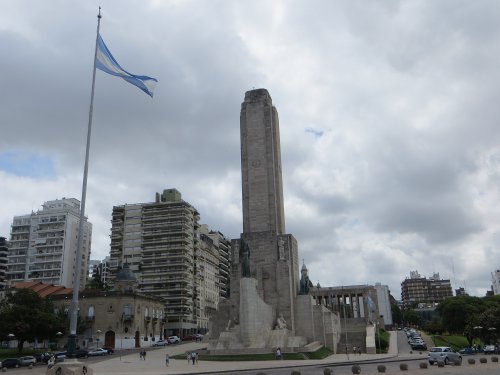
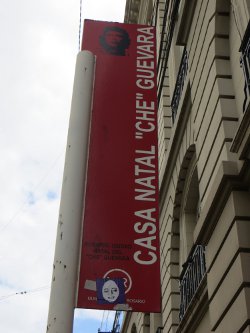
Entre Rios 480: the address of Ernesto ‘Che’ Guevara’s first house. We walked by the apartment building that continues to be a private home.
Parque Independencia: Independence Park is a large public park located in the geographical center of the city. The entrance of the park features the day of the week, date, month, and year written with flowers and surrounded by a garden.


Museo Historico Provincial – Dr Julio Marc: this museum exhibited well-presented collection of post-independence exhibits plus excellent displays on indigenous cultures from all over Latin America.
Costanera Norte: we spent an afternoon on the beaches of Balneario La Florida with some friends having mate.
Cordoba
Plaza San Martin: the city’s central plaza dating back to 1577.
Cabildo: located on the western side of Plaza San Martin, this colonial town council building was completed in 1785. It contains three interior patios and basement cells, which we got to visit as part of the Museo de la Ciudad (City Museum). The museum exhibited the history of the city.
Cathedral Church: the construction of the city’s cathedral began in 1577 and dragged on for more than two centuries under several architects, including Jesuits and Franciscans.
Paseo del Buen Pastor: this cultural center / performance space was built in 1901 as a combined chapel, monastery and women’s prison. In mid-2007 it was re-inaugurated to showcase work by the city’s artists. We were able to see paintings by local artists that were displayed on the exterior of the building.
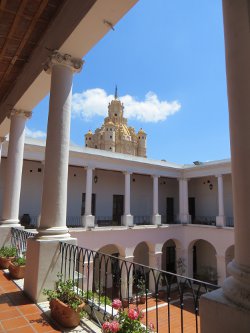
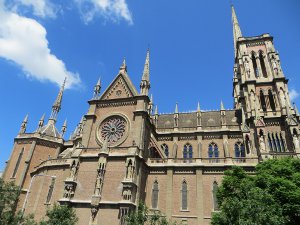
Parroquia Sagrado Corazon de Jesus de los Capuchinos: we went inside this neo-Gothic church built between 1928 and 1934. The uniqueness of this church is that it is missing a steeple, which was omitted on purpose to symbolize human imperfection.
Parque Sarmiento: named after a former president, this park is the largest in the city. The park is also home to the Faro del Bicentenario, a twisted modern-looking lighthouse.
Palacio Ferrerya: this palace was built in 1914 and designed by Ernest Sanson. The building’s architecture is amazing and the interior hosts a fine-arts museum that featured 12 rooms spread over three floors.
Cordoba Observatory: belonging to the National University of Cordoba, this observatory was founded on October 24, 1871 by President Domingo F. Sarmiento.

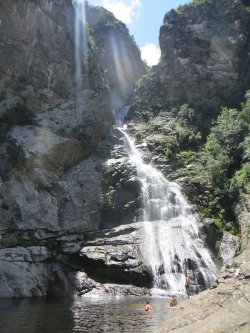
Los Chorrillos Waterfall: we took a day trip outside the city to the eastern foothills of the Sierras Grandes to visit this private reserve. After a 7 km (4.3 miles) hike, we arrived to a 115-meter (377 ft) beautiful cascading waterfall in which it was irresistible to go for a swim.
Colegio Nacional de Monserrat: this school dates from 1782, though the college itself was founded in 1687 and transferred after the Jesuit expulsion. The interior is now a museum with artifacts that date back when it was in use.
Iglesia de la Compania de Jesus: we went inside this church that was designed by the Flemish Padre Philippe Lemaire that dates from 1645 but was not completed until 1671.
Iglesia de Santa Teresa y Convento de Carmelitas Descalzas de San Jose: this church and convent was completed in 1628 and has functioned ever since as a closed-order convent for Carmelite nuns. We were only able to visit the church itself.
Manzana Jesuitica: the city’s beautiful Jesuit Block was initially associated with the influential Jesuit order. In 2000, Unesco declared it a World Heritage site and now hosts Museo Historico de la Universidad Nacional de Cordoba.
- Museo Historico Provincial Marques de Sobremonte: known as one of the most important historical museums in the country, the 18th century colonial house once belonged to Rafael Núñez, the colonial governor of Córdoba and later viceroy of the Río de la Plata. It has 26 rooms, seven interior patios, meter-thick walls and an impressive wrought-iron balcony. The museum contained artifacts that dated back to the colonial period before slavery was abolished.

Valle Hermoso
Visiting some friends of friends that live in this village was a relaxing way to spend the day. We spent a day at their countryside home and then they took us to see the surroundings. We spent the afternoon picnicking alongside a pristine river with interesting cave formations and ruins of the local indigenous, Comechingones.
Alta Gracia
Jesuit Estancia: we toured this estancia that contained the Museo Historico Nacional del Virrey Liniers, named after a former resident that was one of the last officials to occupy the post of viceroy. The museum exhibited many artifacts and how life was during the estancia period.
Iglesia Parroquial Nuestra Señora de la Merced: Jesuit fathers built this church, located adjacent to the estancia, in 1762.

Museo Casa de Ernesto Che Guevara: in the 1930s, the family of young Ernesto Guevara moved here because a doctor recommended the dry climate for his asthma. The city purchased their house and restored it as this museum. The interior is adorned with a photographic display of Che’s life, mainly his childhood. One interesting exhibition was the motorcycle he used to travel throughout Latin America and a map detailing his multiple journeys.
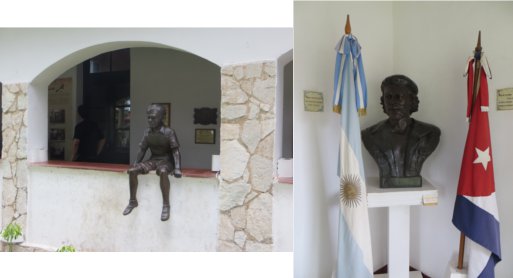
Mendoza
Plazas: the city’s five central plazas are arranged like the five-roll on a die, with the largest, Plaza Independencia, in the middle and four smaller plazas, Plaza Italia, Plaza España, Plaza Chile, and Plaza San Martin, lying two blocks from each of its corners.
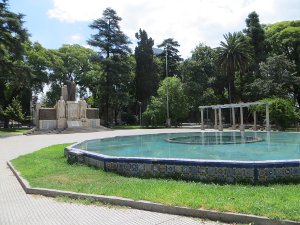
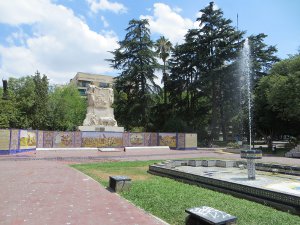
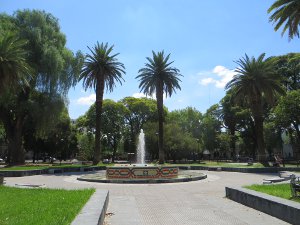
Museo Fundacional: this museum is located above excavations of the colonial cabildo (town council), destroyed by an earthquake in 1861. The museum takes you through the history of the city from prehistoric times to the destruction of the city by this earthquake and the reconstruction of the city, which geographically shifted southwest. The museum also managed the adjacent Ruinas Jesuiticas de San Francisco, ruins of a Jesuit church that was also destroyed by the earthquake.
Iglesia, Convento y Basilica de San Francisco: many locals consider the image at this church of the Virgin of Cuyo, patron of San Martín’s Ejército de los Andes (Army of the Andes), miraculous because it survived Mendoza’s devastating 1968 earthquake.

Museo de Arte Moderno: this small, well-organized museum contained modern and contemporary art exhibits.
Parque General San Martin: we went for a morning walk along the lakeshore of this beautiful 420-hectare park. The main entrance contained impressive entry gates shipped over from England and originally forged for the Turkish Sultan Hamid II. The park was designed by Carlos (Charles) Thays in 1897.
Terraza Mirador: the rooftop terrace at City Hall offered panoramic views of the city and the surrounding area, including the Andes.
Maipu: this small town just outside of Mendoza is packed with wineries and olive oil farms. We rented bicycles and spent a day visiting a few businesses. Our first stop was at Carinae Wines, a small, French-owned winery producing good reds; we then headed across the road to LAUR Olive Oils, a 100-year-old olive farm, where we took a tour of the complex and learned about olive oil production and of course sampled their various oils; next was Di Tomasso Wines, a beautiful, historical vineyard dating back to the 1830’s, where we toured the original cellar section; and our final stop was Tempus Alba, where we savored their wines overlooking their vineyards.

Bariloche

Museo de la Patagonia: the museum is filled with archaeological and ethnographic materials, Perito Moreno’s life story, different exhibitions on the indigenous of Patagonia, including the Mapuche resistance to the Conquest of the Desert, and life in colonial times in the Patagonia.
Catedral Nuestra Señora del Nahuel Huapi: the main Catholic church in the city, it was designed by the architect Alejandro Bustillo, who offered his services for free.
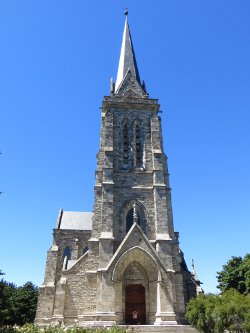
National Park Nahuel Huapi: this park occupies 7500 sq km with the centerpiece as Lake Nahuel Huapi. The park was created to preserve local flora and fauna, including its Andean-Patagonian forests and rare animals. We visited part of the park that is known as the Circuito Chico where we hiked up for 20 minutes to Cerro Campanario to get a panoramic view of Lake Nahuel Huapi and its surroundings. We then continued by bus to Hotel Llao Llao, a famous, fancy hotel located in a scenic valley with amazing views. From there, we hiked for four hours in the Parque Municipal Llao Llao, where we went up Cerro Llao Llao and other gorgeous viewpoints, passed Lake Escondido, and walked amongst a forest of arrayanes.
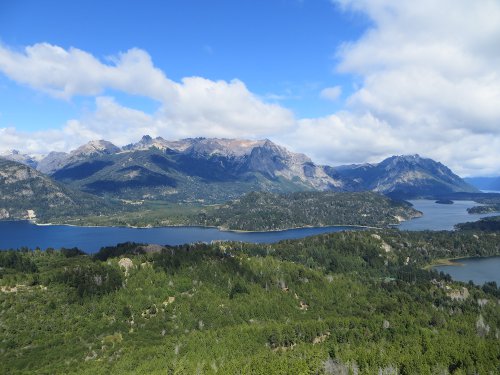
Villa Catedral: this was the start of our 3-hour hike up to Refugio Frey where we had amazing views of Laguna Toncek, the surrounding mountains peaks, and Cerro Catedral, a 2388m (7835 ft) peak.
El Chalten
Capilla de los Escaladores: a simple chapel of Austrian design memorializes the many climbers who have lost their lives to the dangerous peaks since 1953.

Glaciers Nacional Park – North Zone: the northern part of the park, known as the Fitz Roy Range – with its rugged wilderness and shark-tooth summits – is the trekking capital of Argentina. We spent two nights and three days in this beautiful wilderness. Our first day, we trekked two-and-a-half hours passing ñire forest and a Fitz Roy Viewpoint to Campamento Poincenot. After setting camp, we continued hiking for an hour to Piedras Blancas Glacier. We sat admiring the colossal size and sounds of small avalanches. The next day we hiked the strenuous zigzag trail to Laguna de los Tres with amazing clear views of the 3,405m (11,171 ft) Cerro Fitz Roy. After packing up our camp, we trekked another two-and-a-half hours passing Laguna Madre and Laguna Hija, and crossing over Fitz Roy River to arrive at Campamento De Agostini. On our final day, Sal hiked to Laguna Torre Viewpoint for majestic views of the lagoon and Cerro Torre, an extraordinary 3,128m (10,262 ft) rock spire, set above intersecting glaciers. He then continued hiking for about an hour passing a roaring river and a forest carpeted by a lush green moss to arrive at Maestri Viewpoint, for closer views of Cerro Torre and the surrounding glaciers. After packing up, we finished our day by trekking a final two-and-a-half hours back to El Chalten.

El Calafate
Glaciers National Park – South Zone: the main attraction in the south part of this national park is Perito Moreno Glacier. After seeing a few glaciers in our previous treks, we did not have much expectations of Perito Moreno. As we started to walk down one of the almost 4,000m (13,123 ft) of man-made catwalks, our prospects continued to drop as we thought to ourselves, “Why the need for metal and concrete jungle in the middle of the beautiful nature!” But as soon as we were able to get close enough on the catwalks to see the stunning glacier, all of our pretenses were answered! We have never laid eyes on a work of art so colossal, so colorful, and so amazing made by Mother Nature. At 30km (18.6 miles) long, 5km (3.1 miles) wide, and between 50 to 60m (164 to 197 feet) high it goes to show just how small we are in this world. Not only is the size impressive, but also the sounds are extraordinary. We spent hours starring into the array of blue and white colors and listening to the creeks made by ice cracking and the thunderous sound of building-sized icebergs as they hit the water. The glacier creeps forward up to 2m (6.6 ft) per day, which is exceptional considering other glaciers around the world are receding. Perito Moreno is considered stable.

Ushuaia
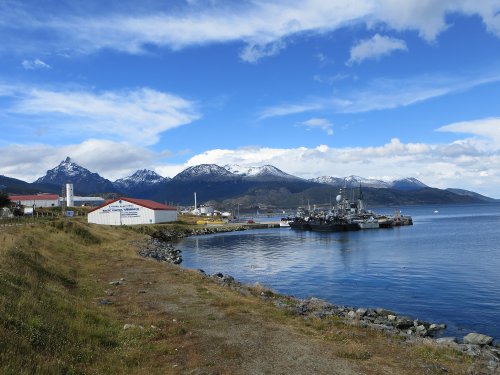
Museo Maritimo & Museo del Presidio: this former national prison was built by convicts that were transferred from Staten Island to Ushuaia in 1906 and finished in 1920. The cells, designed for 380 inmates, held up to 800 before closing in 1947. Now it hosts several museums, including Prison Museum, Maritime Museum, Art Galleries, Antarctic Museum, Police Museum, and Ushuaia City Museum.
Museo del Fin del Mundo: built in 1903, this former bank turned museum (End of the World Museum) contains exhibits on the local natural history, indigenous life, and early penal colonies.

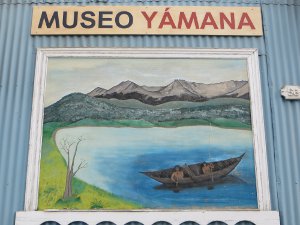
Museo Yamana: an excellent museum overviewing the Yamana, local indigenous group, way of life. The museum documented various aspects such as their survival in harsh weather without clothing, the fact that women were the only ones that swam, the children would keep the campfires going in moving canoes, and how Europeans drove them to near extinction by giving them clothes, diseases, and by murdering them.
Antigua Casa de Gobierno: this former Government House was the first seat of government of the National Territory of Tierra del Fuego, Antarctica, and South Atlantic Islands and then the territorial and provincial legislature until 2002. It is now a museum exhibiting government and legislative artifacts.
Parque Nacional Tierra del Fuego: located 12km (7.5 miles) west of Ushuaia, this national park was Argentina’s first coastal national park and extends from the Beagle Channel in the south to beyond Lago Fagnano in the north. We trekked in the park for three days and two nights, in which most of the time was cloudy, but we were still able to make the most of our stay in this unique part of the world. We took public transportation into the park and set camp at Campamento Ensenada. We then hiked for two hours to Pampa Alta at an altitude of 315m (1,033 ft) with limited cloudy views across the Beagle Channel and then continued to Rio Pipo Waterfall. The next day we trekked 8km (5 miles) along Senda Costera (Coastline Path) and although it was another cloudy day, we passed some beautiful colorful bays and mounds of conchales (mounds of shells left by the indigenous inhabitants). After setting up camp at Campamento Laguna Verde, we hiked along some short paths, such as Senda Castorera (Beaver Path), where we witnessed abandoned beaver dams and the destruction these furry creatures have created in this natural wonder. The beavers were introduced to this area many years ago for their fur, but they have destroyed much of the fragile ecosystem. Unfortunately, the trees in this area do not recuperate as quickly as they do in North America, their natural habitat, and they do not have any predators here to be able to control the over population. The last few years the rangers have been able to hunt a majority of them and control the continuous spread. On our final day in the park, we had clear skies and trekked 10km (6.2 miles) along the beautiful shores of Lago Roca on the Senda Hito XXIV getting to the Argentina-Chile border. It was a great way to end our time in the national park before heading back to Ushuaia.
Puerto Iguazu
Iguazu National Park: when we entered the park we first went to a small museum in the visitor’s center that displayed Guaraní (local indigenous) life and the flora and fauna of the park. We then spent the day admiring the waterfalls from different angles from the trails, bridges, and boardwalks. The most impressive view was of the Garganta del Diablo (The Devil’s Throat), where the lookout platform is perched right over the amazingly powerful cascading waters. Part of the adventure was getting there, walking on the boardwalk that traverses over River Iguazu.

